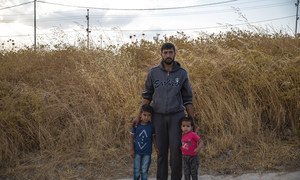Amidst protection challenges, Eastern Route outpaces Mediterranean for people leaving Africa

A Somali woman arrives in Yemen.
14 February 2020
A
monthly average of 11,500 people traveling from the Horn of Africa to
Yemen last year made the so-called Eastern Route the busiest maritime
migration path on earth, the UN migration agency said on Friday.
Most
are unaware of the security situation in Yemen where they face serious
protection concerns, including active fighting, or abuses such as
kidnapping, torture for ransom, exploitation and trafficking.
“While tragedies along the Mediterranean routes are well reported, our staff bear witness daily to the abuse suffered by young people from the Horn of Africa at the hands of smugglers and traffickers exploiting their hopes for a better life,” said Mohammed Abdiker, International Organization for Migration (IOM) Regional Director for the East and Horn of Africa.
Data collected by IOM’s Displacement Tracking Matrix revealed that over 138,000 people crossed the Gulf of Aden to Yemen last year, as compared to the more than 110,000 migrants and refugees who crossed the Mediterranean Sea to Europe during that same period.
And this is the second year in a row that the Eastern Route reported more crossings than the Mediterranean. In 2018, roughly 150,000 people made the journey.
“To get to Yemen, they crammed about 280 of us into one boat,” a thirty-two-year-old Ethiopian man told IOM in Aden, Yemen. “There was no oxygen, and some people committed suicide by throwing themselves into the sea.”
An eighteen-year-old Ethiopian migrant said: “We were beaten, tortured, abused and threatened for ransom. My family sent $900 to save my life so I was released.”
Approximately 92 per cent of those who disembarked in Yemen were Ethiopian nationals, the vast majority of whom aimed to continue to Saudi Arabia.
Smugglers and traffickers also operate boats from Obock in Djibouti and Bosasso in Somalia. Last year, 38 per cent of migrants arrived from Djibouti and 62 per cent from Somalia.
The journeys from their home to Saudi Arabia can take months or even longer, depending on whether they stop to work or are detained along the way.
While IOM works across the Horn of Africa and the Arabian Gulf to provide life-saving emergency support to migrants in need and support development in home communities, the agency maintains that legal pathways for migration are “the most effective protection mechanism for migrants”.
“IOM is committed to supporting all authorities along the Eastern route to better manage migration, ensuring the safety and dignity of migrants”, underscored Mr. Abdiker.
“While tragedies along the Mediterranean routes are well reported, our staff bear witness daily to the abuse suffered by young people from the Horn of Africa at the hands of smugglers and traffickers exploiting their hopes for a better life,” said Mohammed Abdiker, International Organization for Migration (IOM) Regional Director for the East and Horn of Africa.
Eastern route spike
After five years of conflict in Yemen, the Eastern Route has spiked as travelers appear undeterred by the Gulf’s strict immigration policies for undocumented migrants.Data collected by IOM’s Displacement Tracking Matrix revealed that over 138,000 people crossed the Gulf of Aden to Yemen last year, as compared to the more than 110,000 migrants and refugees who crossed the Mediterranean Sea to Europe during that same period.
And this is the second year in a row that the Eastern Route reported more crossings than the Mediterranean. In 2018, roughly 150,000 people made the journey.
“To get to Yemen, they crammed about 280 of us into one boat,” a thirty-two-year-old Ethiopian man told IOM in Aden, Yemen. “There was no oxygen, and some people committed suicide by throwing themselves into the sea.”
An eighteen-year-old Ethiopian migrant said: “We were beaten, tortured, abused and threatened for ransom. My family sent $900 to save my life so I was released.”
Perilous journey
Those making the perilous journey – crossing deserts and territories controlled by armed groups, with little food or water – either travel in search of economic opportunities or are fleeing insecurity, human rights abuses and adverse living conditions.Approximately 92 per cent of those who disembarked in Yemen were Ethiopian nationals, the vast majority of whom aimed to continue to Saudi Arabia.
Smugglers and traffickers also operate boats from Obock in Djibouti and Bosasso in Somalia. Last year, 38 per cent of migrants arrived from Djibouti and 62 per cent from Somalia.
The journeys from their home to Saudi Arabia can take months or even longer, depending on whether they stop to work or are detained along the way.
While IOM works across the Horn of Africa and the Arabian Gulf to provide life-saving emergency support to migrants in need and support development in home communities, the agency maintains that legal pathways for migration are “the most effective protection mechanism for migrants”.
“IOM is committed to supporting all authorities along the Eastern route to better manage migration, ensuring the safety and dignity of migrants”, underscored Mr. Abdiker.


No comments:
Post a Comment